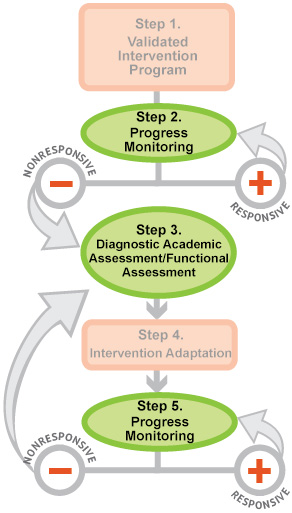Intensive Intervention (Part 2): Collecting and Analyzing Data for Data-Based Individualization
Wrap Up

Data-based individualization, or DBI, offers a systematic approach for gradually individualizing and intensifying interventions for students with severe and persistent academic difficulties. This is accomplished through the systematic use of assessment data, validated interventions, and research-based adaptation strategies. When they implement the DBI process, teachers collect and evaluate data during three of the five steps in the process. They use these data to make informed instructional decisions.
- Step 1: Validated Intervention Program*
- Step 2: Progress Monitor—The teacher collects formative assessment data to determine how a student is responding to the validated intervention program.
x
formative assessment
A system of providing continual feedback about students’ preconceptions and performances to both learners and instructors; an ongoing evaluation of student learning.
- Step 3: Diagnostic Academic Assessment—The teacher collects assessment data to determine why the student is not responding adequately to the validated intervention program.
- Step 4: Intervention Adaptation*
- Step 5: Progress Monitor— The teacher collects formative assessment data to determine how a student is responding to the adapted intervention.
This graphic illustrates both the steps of data-based individualization, as well as they ways in which those steps interact. Step 1, “Validated Intervention Program,” is represented by an orange rectangle. This box connects via a vertical grey line to Step 2, “Progress Monitoring,” which is illustrated as a green oval. Both steps, in turn, are connected to a horizontal line with labeled circles at each of its ends. The circle on the left, “Nonresponsive,” has a red minus sign at its center, while the circle on the right, “Responsive,” has a red plus sign. A grey arrow connected to the “Nonresponsive” circle points toward Step 3 of the DBI process, “Diagnostic Academic Assessment/Functional Assessment,” which is represented as a green oval, similar to Step 2. The “Responsive” circle also has a grey arrow, this one pointing back up toward Step 2, “Progress Monitoring.”
Step 3 is connected via a vertical grey arrow to Step 4, “Intervention Adaptation,” represented as an orange rectangle. Another grey arrow connects Step 4 to Step 5, “Progress Monitoring,” another green oval. As above, these latter steps are connected to a horizontal line with labeled circles at each of its ends. The circle on the left, “Nonresponsive,” has a red minus sign at its center, while the circle on the right, “Responsive,” has a red plus sign. A large grey arrow connected to the “Nonresponsive” circle points back to Step 3, “Diagnostic Academic Assessment/Functional Assessment,” while the “Responsive” circle directs instructors back to Step 5, “Progress Monitoring.”
This module page focuses on Steps 2, 3, and 5, so those green ovals are highlighted whereas the rest of the graphic is slightly faded out.
DBI is an ongoing process of collecting data and making informed instructional decisions. Teachers collect primarily two types of data: progress monitoring and diagnostic assessment. These data help determine how and when students need additional support or interventions.
| DBI Process | |
|---|---|
| Type of Data | Purpose |
| Progress Monitoring |
|
| Diagnostic Assessment |
|
Once the teacher has conducted a diagnostic assessment, he or she needs to use the results of the assessment to make data-based instructional decisions. For students like Natalia who do not show improvement after the five-step cycle has been implemented, the teacher repeats the cycle beginning with Step 3, a diagnostic assessment. After Steps 3–5 have been repeated, Natalia demonstrates improved outcomes. For students like Natalia, it might take repeating the last three steps of the cycle a number of times before teachers find an instructional approach to which the student positively responds.
Listen as Chris Lemons summarizes the types of data collected and analyzed during the DBI process (time: 2:13).

Transcript: Chris Lemons, PhD
In this module, you learned about various assessments that are used to guide the DBI or data-based individualization process. The two types of measurement are progress monitoring and diagnostic assessment. Progress monitoring—for example, curriculum-based measurement or CBM—is really important in DBI because it provides instructors with a set of baseline data that can be used to determine appropriate goals and to evaluate response to the interventions and adaptations that you’ve provided. A great thing about curriculum–based measurement or CBM is that it provides a reliable, valid, and efficient assessment tool for teachers to get a really good snapshot of where students are when they start the DBI process and to monitor the progress to see if students are responding to the interventions that are being provided.
The second form of assessment that was covered in this module is diagnostic assessment. Diagnostic assessment allows teachers to go a little bit deeper. This type of assessment allows instructors to understand why a student may be non-responsive. So instead of a simple brief one-minute CBM, often teachers are going to provide additional assessments, perhaps more standard assessments. They also may do a qualitative analysis of the data collected in CBM, so instead of simply getting a score of how many words correct per minute, they may do some investigation of the type of errors that were made when the student was reading. And this information is important because it can be used to provide guidance for making adaptations to instruction. The diagnostic piece is critical because it ensures that teachers are using data to guide the adaptations to instruction.
So assessment data are critical aspects of the DBI process. And in current schools, many teachers are collecting a large amount of data. The reason for this is primarily because many schools are implementing RTI or MTSS and have established systems for progress monitoring. However, in most of these schools, this data is rarely used to actually guide instruction. DBI is a systematic process that can help teachers who are already collecting data make the most of the data they are collecting to improve the outcomes of students with disabilities.
Revisiting Initial Thoughts
Think back to your initial responses to the following questions. After working through the resources in this module, do you still agree with your Initial Thoughts? If not, what aspects of your answers would you change?
What is data-based individualization?
How can school personnel use data to make instructional decisions?
When you are ready, proceed to the Assessment section.